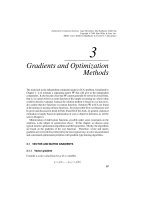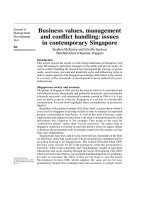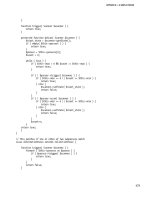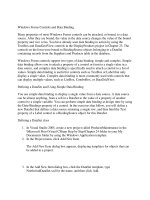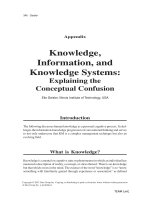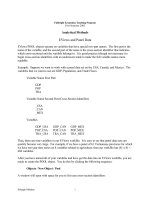Tài liệu Knowledge-Based Enterprise: Theories and Fundamentals - Appendix ppt
Bạn đang xem bản rút gọn của tài liệu. Xem và tải ngay bản đầy đủ của tài liệu tại đây (1.07 MB, 37 trang )
346 Geisler
Copyright © 2007, Idea Group Inc. Copying or distributing in print or electronic forms without written permission
of Idea Group Inc. is prohibited.
Appendix
Knowledge,
Information, and
Knowledge Systems:
Explaining the
Conceptual Confusion
Elie Geisler, Illinois Institute of Technology, USA
Introduction
The following discusses human knowledge as a personal cognitive process. It chal-
lenges the information-knowledge progression of conventional thinking and serves
to not only underscore that KM is a complex management technique but also an
evolving eld.
What is Knowledge?
Knowledge is a mental or cognitive state or phenomenon in which an individual has
mastered a description of reality, a concept, or slices thereof. There is no knowledge
but that which exists in the mind. The essence of the word “knowledge” is to “know
something with familiarity gained through experience or association” as dened
TEAM LinG
Appendix 347
Copyright © 2007, Idea Group Inc. Copying or distributing in print or electronic forms without written permission
of Idea Group Inc. is prohibited.
in the dictionary. Hence, experiences or associations are phenomena of cognition,
which occur in the mind.
Does this focused denition of knowledge necessarily prescribe the doom of knowl-
edge systems in organizations? Not in the least. There is ample room and compelling
reasons for knowledge systems to exist. The purpose of this chapter is to clarify the
confusion that seems to pervade the literature as to what constitutes knowledge and
how it relates to information.
The assertion that knowledge, as we dene it, exists only as a cognitive phenom-
enon has been previously addressed by those who considered the existence of
“tacit” knowledge. Michael Polanyi coined this term and advanced the argument
that
there are two types of knowledge: (1) “tacit,” which is knowledge contained in
the person’s mind, and (2) “explicit,” which is knowledge that people externalize,
share, and diffuse. Ikujiro Nonaka and his colleagues extended this typology of
knowledge. They revealed the method used by successful Japanese companies to
facilitate the sharing of knowledge by their members, thus turning “tacit” knowledge
into “explicit” knowledge.
In this literature, both types of knowledge are considered as equal aspects of the
phenomenon of knowing. The difference between them seems to be the locus of the
knowledge. Tacit means it is embedded in the cognitive or mental enclosure and
explicit means that the knowledge has already been diffused outside the individual’s
mind.
Here knowledge is dened solely as a phenomenon of the mind. Explicit, shared,
or diffused knowledge is not true knowledge. Whatever the entity that oats in
databases, information systems, or knowledge systems, it is not knowledge but the
externalization of the processes of the human mind, which are the only constituent
components of knowledge.
Human beings who live in societies must share what they know with others. The
motives for this are survival, competitive pressures, and the need to grow and to
add to our stock of skills, competencies, and capabilities. Add to these our need to
cooperate to achieve complex tasks, and the result is the plethora of social, economic,
organizational, and psychological reasons for the drive to share what we know and
to tap the knowledge of others.
To do so, we devised means of communication, both nonverbal and languages. As
philosophers such as Ludwig Wittgenstein and linguists such as Noam Chomsky
have suggested, language allows us to exchange our description and understanding
of reality—albeit in an imperfect mode. We are able to create linguistic artifacts,
such as intellectual nuggets, which are statements about reality, as we know it
and as we are able to share and to externalize it. Polanyi had even suggested that
“tacit” knowledge is that knowledge which individuals are yet unable to externalize.
But the issue is not the matter of where such sharing will occur, nor that all tacit
knowledge may at some point become explicit. The issue is that, as individuals, we
TEAM LinG
348 Geisler
Copyright © 2007, Idea Group Inc. Copying or distributing in print or electronic forms without written permission
of Idea Group Inc. is prohibited.
are bound by our ability to express our knowledge, to translate what we know into
“shareable” quantities, and to externalize it via the communicative and linguistic
tools we possess. Barring direct access by others to the crevices of our mind and a
direct reading of our cognitive thoughts, we are limited in our ability to externalize
what we know.
Externalized knowledge is not knowledge. It is a limited translation or, in graphic
terms, a fuzzy picture of whatever knowledge we were able to share via the tools of
human communication and language. What exists outside the mind is in the form of
a collection of linguistic artifacts. These are “intellectual nuggets,” which may be
propositions, statements, formulae, symbols, or any other manifestation of human
communication tools and devices.
This picture or projection of our reality (as we know it) is what we share and com-
municate to others. All such “explicit” projection of what we know is not only
an incomplete and, to an extent, biased imprint of what we know, but it also is
exposed to the tribulations of the shortcomings and barriers embedded in human
communication.
What is Information?
What is this externalized form of what we know? As faulty and “non-knowledge”
as it may be, this is a projection or representation of the reality as we are able to
provide to others. Human interaction and our innate ability to communicate conjure
to create a standardized mode of expressing this reality.
Once externalized, this description of reality (intellectual nuggets) loses its cogni-
tive characteristics and its personalized format, which is the essence of knowledge.
What is left is a collection of nuggets, standardized to a point where all who are
versed in the “key” to deciphering this description are able to access and to absorb
and comprehend its content.
Perhaps the term “information” is appropriate to describe and to identify this col-
lection of externalized nuggets. The distinction made here is therefore not between
“tacit” and “explicit” forms of knowledge, but between “knowledge” and a radi-
cally different form of description of reality, accessible to all, and residing outside
the mind.
This distinction is not just a matter of semantic triing. Rather, there are substantive
differences between knowledge and what we may call “information.” In addition
to the different location of its existence, information is a “processed” description
of reality, presented in a standardized form. Once acquired, interpreted, “read,”
or deciphered, this “information” is not knowledge—it remains the externalized
projection of what we know.
TEAM LinG
Appendix 349
Copyright © 2007, Idea Group Inc. Copying or distributing in print or electronic forms without written permission
of Idea Group Inc. is prohibited.
For example, I know that upon my study of an organization, it is faltering and on
a verge of collapse. I compose a report in which I detail this conclusion and how
I arrived at it, my methodology, and my initial assumptions. This report contains
intellectual nuggets, which are opinions, lessons, ndings, conclusions, and de-
scriptions of the organization and my exploration of its existence and its workings.
The report is not knowledge. It contains “information” about the organization. The
reader of the report does not know that the organization is on the brink of collapse,
not because my conclusion is subjective, but because the projective “information”
provided in my report needs to be absorbed by the mind of the reader and undergo
the processes of generation of knowledge.
Here lies the crux of the differentiation between knowledge and information. As a
cognitive phenomenon, knowledge is created when sensorial inputs are processed
and clustered in the mind. Such nuggets are absorbed through the ve senses and
clustered as a cognitive phenomenon, thus generating knowledge. In a popular ver-
sion, this would be equivalent to not “knowing” until one walks in another’s shoes.
Creating knowledge through sensorial inputs is to experience the reality about which
we generate knowledge.
Challenging the Information-Knowledge
Progression
The act of obtaining and absorbing information about the phenomenon is far from
experiencing it via the clustering of sensorial inputs. Conventional thinking suggests
that we have a progression: from data, to information, to knowledge, and to wisdom.
Such a progression, in my view, is a conceptual and ontological fallacy.
The information-to-knowledge progression conveys the erroneous conception of
how we can transform information into knowledge. To agree with this notion one
must have an adequate theory that will explain how information is processed into
knowledge. Such a theory is yet to be devised. A feeble excuse for the lack of such
a theory is sometimes advanced on the grounds that the mental processes where
information is transformed are the realm of consciousness and we are yet to unlock
this amazing human ability.
However, if we approach this phenomenon with knowledge creation as the starting
point, all that is needed is to establish whether the clustering in the mind is based on
underlying concepts, as argued by some epistemologists, and what are the criteria
for clustering and sensemaking. The creation of knowledge as a mental process is
still a marvel to be unlocked, but there is no requirement in this approach to add a
theory that attempts to explain how information is transformed within these cogni-
tive processes.
TEAM LinG
350 Geisler
Copyright © 2007, Idea Group Inc. Copying or distributing in print or electronic forms without written permission
of Idea Group Inc. is prohibited.
What are Knowledge Systems?
When people externalize what they know, they do so within informal surroundings
and they also do so within organizational boundaries. From times immemorial,
humans externalized what they know to their kinfolk and to the members of their
hunting parties. They raised their young and mentored them in the skills needed for
survival and in understanding their environment.
As formal organizations emerged, there also arises the need to gather, to assemble, and
to store the externalized knowledge of those who possess such knowledge. Initially,
it consisted of a raw collection of skills (how to plow, sow, build bridges, ignite a
re, and make tools). Later, this need has evolved to more complex notions of why
nature behaves as it does (why the seasons of the year, the ooding of the rivers, the
frailty of the human existence, and the birth and death of living organisms).
Organizations thus became harbingers of the knowledge of their members, and a
healthy trading began in such collections. In many instances, a ban was declared over
revealing certain skills and competencies. The Philistines had such a ban on ways
and means of forging weapons—a technology they possessed and kept as secretive
as possible. Over the millennia of human civilization, organizations accumulated
records of externalized knowledge (“information”) for the purposes of conducting
operations and for their performance and survival.
As harbingers of these records, organizations do not “know.” They are repositories
of whatever their past members were good enough to deposit and leave behind.
Such records, containing a variety of topics of information, were used for training,
operations, competition, and growth. Some of the information in these records was
lost because of the unreadable form in which it was produced or stored, or other
attributes of poor communication. Nonetheless, organizations became the key har-
bingers of whatever was shared by individuals after they departed the world of the
living and could not themselves share their knowledge.
Knowledge systems and knowledge-based anything in the organization are there-
fore a misnomer. What is stored in organizational records is “information,” since
knowledge is solely dened as the cognitive activity in the individual’s mind.
However, the information stored in these records is the product of the attempts of
countless individuals to externalize what they know. Hence the connection to the
notion of knowledge.
In the nal decade of the 20
th
century, we forcefully discovered the role that knowl-
edge and its organizational systems play in the working, performance, success, and
survival of the organization and its members. The notion of “knowledge workers”
appeared and management scholars, such as the late Peter Drucker, emphasized their
importance in the changing face of the global economy. What prompted this rush to
identify and to be so laudably concerned with “knowledge-workers?”
TEAM LinG
Appendix 351
Copyright © 2007, Idea Group Inc. Copying or distributing in print or electronic forms without written permission
of Idea Group Inc. is prohibited.
As I suggested in my book Creating Value with Science and Technology, during the
second half of the twentieth century there were three complementary phenomena.
Massive investments by many nations, particularly the United States in publicly
funded science and technology, complemented dramatic improvements in the edu-
cation process. In much of the world, countries have invested in elementary and
higher education to extents never before dreamed by previous governments. Uni-
versity education has become a popular rather than an elitist experience. Thirdly,
dramatic improvements in sea and air transportation and the lowering of tariffs and
several commercial treaties, plus the relative liberalization of economies, which
previously had in place prohibitively defensive tariffs, have all contributed to the
globalization of trade.
When the relative advantages of land, capital, and standardized workforce began
to diminish or disappear, skills, competencies, and “knowledge” have emerged
as crude yet powerful substitutes to the national economic toolkit. Because of the
inherent difculties in sharing and diffusing knowledge, the emphasis on this new
element of economic power is gaining forceful momentum in both business and
academic circles.
In global terms, as the literature on technology transfer has shown in its conclusive
ndings, the simple transfer and diffusion of “what we know” from country to
country in a given area is highly insufcient to train a generation of “knowledge-
able” people. Direct contact and mentoring are necessary so that which is shared
by those who know may be absorbed by those who don’t know to some degree of
adequate use.
Within this trend of the focus on and the veneration of knowledge, organizations
are increasingly creating and restructuring their “knowledge systems.” These are
collections of records deposited by individual members, past and present, who had
knowledge about a topic, a given area, or an answer to a specic query. As they
indulge in developing and using these systems, organizations are also becoming
painfully aware of at least three problems. First, whatever they accumulate in their
“knowledge systems” is only a fraction of what their members actually know.
Secondly, members are very reluctant to share what they know and to deposit what
they know in these systems. Thirdly, unlike libraries and traditional information
systems, “knowledge systems” are a different type of repository. If a member of
the organization needs to know how many people are employed by a competing
company, she can nd this item in a traditional information system, library, or
depository. If, however, the member wishes to know what are the comparative ad-
vantages of the competing company in the commercialization of nanotechnology,
such “knowledge” is not readily available nor is it accessible in the organization’s
systems. “Knowledge systems” are excruciatingly difcult to structure, manage,
maintain, and utilize.
TEAM LinG
352 Geisler
Copyright © 2007, Idea Group Inc. Copying or distributing in print or electronic forms without written permission
of Idea Group Inc. is prohibited.
Why the Confusion?
If, as proposed here, all that is available in systems, records, and any medium
outside the human mind is, at best, information—not knowledge—then we have
some level of confusion between the concepts of information and knowledge. The
issue, therefore, is not how to better and more fully extract “tacit” knowledge from
organizational members. Rather, the issue is how to reconcile the coexistence of
information (as the externalized mode of what we know) and knowledge (as the
cognitive processes in the mind).
These two very distinct phenomena (information and knowledge) seem to not only
coexist but also have some interaction, via the knower and the user of the externalized
content. However we choose to name these phenomena, we have mental processes
on the one hand and a collection of the externalized reection or projection of these
processes on the other. They are somehow connected, they are related, and they
interact in the activities of organizational members.
We have therefore a gap between what we know, and the volumes of collected
material from many individuals. This material is viewed as the externalization of
what these other individuals had chosen to share and to deposit in the repository.
The gap is conceptual: how do we transform one into the other? How do we make
the interaction a successful event, when knowledge and information available in
repositories are such different phenomena?
Consider a mundane example of a pedestrian skill. I gain access to a repository
of information about tying the laces of shoes. I am exposed to text, graphics, and
movies about how laces are tied. With all this information absorbed, I still do not
know how to tie the laces of my shoes. I need to see the laces, touch them, try, fail,
try again, and nally complete the cognitive process in my mind where the result is
that I now know how to tie the laces of my shoes. Having access to the information
about the skill does not make knowledge of the skill, nor of more complex forms
of knowledge such as abstract notions and conceptual views of reality.
Explaining the Gap:
A Theory and Some Applications
To explain the gap between the phenomena of “knowledge” and its external projection
as “information” we need a theory of the “interaction” between the two phenomena.
This theory would attempt to explain: (1) how we externalize what we know in the
form of intellectual nuggets, (This means how we translate our cognitive processes
into communicative artifacts so that we may share our mental capacities with others),
TEAM LinG
Appendix 353
Copyright © 2007, Idea Group Inc. Copying or distributing in print or electronic forms without written permission
of Idea Group Inc. is prohibited.
and (2) how we input “information” or the externalized communication artifacts
and process them in our mind, as we do with clustering of sensorial inputs to create
the mental capabilities we call knowledge.
The rst question this theory would attempt to explain has been formidably ad-
dressed in studies of human communication, semantics, linguistics, and semiotics.
The second question is the crucial task of this “theory of interaction.” It deals with
the difcult objective of explaining how we create knowledge not from the “raw
material” of sensorial inputs, but from the assembly of regurgitated items of what-
ever others have externalized and communicated outside their minds. How do we
input, process, and convert this material into “knowledge?”
There are cognitive, philosophical, and biological aspects to this theory. The men-
tal processes in this case would perhaps be different from those that command
the clustering of sensorial inputs. Consider, for instance, the biological function
of generating energy in the body. Energy can be generated by digesting food, ex-
tracting its nutritional components, and transforming them into energy in the cells.
This process is similar to the creation of knowledge from the mental “digestion” of
sensorial inputs. Conversely, if we inject energy-producing agents directly into the
cell, the process of generating energy will be quite different.
The philosophical aspect of this theory intersects with the problem of induction. Sir
Karl Popper argued that, with his conjectural knowledge, he had solved the problem
of induction by offering a good solution to David Hume’s logical and psychological
queries and to Bertrand Russell’s struggle with this issue.
Hume’s approach to induction was focused on the unique role of experience in shaping
human reasoning. He argued that the generation of “general laws” or “expectations
of regularities in nature” is a mental process based on our prior experiences. As we
experience regularities in natural or other phenomena, we therefore project them
to expectations and general laws (induction from the particular to the general). But
Hume also suggested that humans associate ideas to create cognitive generalizations
of phenomena in their surroundings—in the absence of experience. Hume justied
such human attribution as a result of faith.
Popper combined what he described as Hume’s logical and psychological problems of
induction, and offered his solution. He proposed “conjectural knowledge” by which
all universal laws or theories are conjectural and empirical explorations of these
generalizations can be refuted but their “truth” cannot be established empirically.
The conjecture solution proposed by Popper greatly contributed to the philosophy
of science and to scientic methodology. Donald Campbell relied on Popper’s
philosophical constructs when advancing his “evolutionary epistemology.” But
such advances in philosophy and methodology have not contributed to clarifying
the gap between the sensorial impacts we gather from our world and the formation
of knowledge as mental-cognitive processes.
TEAM LinG
354 Geisler
Copyright © 2007, Idea Group Inc. Copying or distributing in print or electronic forms without written permission
of Idea Group Inc. is prohibited.
Popper addressed this issue in his description of the “three worlds” of our perception
of reality. The rst world is the physical, the second the mental, and the third consists
of ideas or thoughts. He believed that such entities of the “third world” are human
discoveries and do exist outside the mind and apart from the physical world.
Although this is an elegant attempt to offer a solution to externalized knowledge,
the ontological autonomy with which Popper endows human ideas and human con-
ceptualization of reality is at best an egregious explanation. Human knowledge is
more complex than ideas and universal laws. It contains skills, competencies, and
capability to link, connect, assemble, and cluster disparate inputs. The externaliza-
tion of, say, the theory of numbers (to use Popper’s example) as a “man-made”
conception of a certain reality does not make it ontologically independent from the
mind which created such notions. The theory of numbers or the description of the
evolution of biological systems or business corporations is not knowledge. Only
when this “third-world” (in Popper’s terminology) is combined with the human mind
(the “second world”) do we have knowledge. Ontologically such notions exist in
records, documents, tombs of ancient kings, or supercomputers—but they are, for
the purpose of knowledge, as “alive” or “knowing” as the paper, stone, or silicon
chip in which they exist.
All this is different from what Popper termed the “bucket” vs. the “searchlight”
approaches to knowledge, and the creation of scientic knowledge. The “bucket”
approach argues that observations (experiences) precede hypotheses. In his approach
to the methodology of scientic hypotheses, Popper suggested the “searchlight” ap-
proach, in which hypotheses precede observations and are thus tested by empirical
observations. This methodological procedure for scientic exploration represents
a focused view of how one should go about studying the world outside the mind.
However, we go about it, the inputs to the human mind remain within the connes
of the senses, which are then clustered to form higher-order knowledge such as
concepts and theories. On the other side, the externalized form of such knowledge
is re-absorbed by the human mind in a reverse process by which, I suggest, the
externalized knowledge is “decomposed” into sensorial inputs and reassembled in
the mind.
In summary, I suggest that the only possible process of cognition (and knowledge
creation) is the mental process by which the neurons in the human brain cluster sen-
sorial inputs. The belief (expressed by many philosophers and cognition scientists)
that humans have the mental ability to produce, input, and process ideas, concepts,
and theories is false. The process is as follows (Figure 1):
We are currently in the very preliminary stages of uncovering the process of (A)
above—how sensorial inputs are clustered. Recent ndings suggest that fewer neu-
rons than we had believed are involved in clustering sensorial inputs such as images
(vision) for the creation of knowledge about famous people’s faces stored in our
TEAM LinG
Appendix 355
Copyright © 2007, Idea Group Inc. Copying or distributing in print or electronic forms without written permission
of Idea Group Inc. is prohibited.
memory. We are beginning to gain insights into the efciency or our brain, but we
are still far from uncovering the processes described in (A) and (B) in Figure 1.
Some Implications
The view expressed here (that knowledge is narrowly dened with the knower,
and all externalized forms are not knowledge) has some applications in the design
of information and knowledge systems. If, as we are now discovering, our mental
processes are very efcient and we need very few indicators, metrics, or sensorial
inputs to create very complex concept, then the implication for knowledge and in-
formation systems is a call for efcient and very economical content in the design.
As I had suggested in my book, Knowledge and Knowledge Systems: Learning
from the Marvels of the Mind, a small number of sensorial inputs is sufcient to
form complex mental notions. In addition, the cumulative impact of previously
processed sensorial inputs and deposits in our mental memory contribute to an even
more efcient, and certainly more effective processing of sensorial inputs to create
knowledge in the form of complex notions, concepts, and theories.
Another implication is in the reassessment of the key concerns in the design and
management of organizational knowledge systems. Currently we are mainly focused
on the issues of tapping tacit knowledge, combining it with “explicit” knowledge,
and learning by being embedded in external networks. A reassessment would change
the problem from tapping tacit knowledge to designing a knowledge system in
which the content deposited by organizational members will be in a form amenable
to processing by other members or users of the system (per knowledge process B
previously shown).
Figure 1. Schematic of knowledge cognition process
(A) Sensorial inputs Knowledge (skills, ideas, theories, concepts,
competencies)
B) Externalized Sensorial Knowledge (skills, ideas, theories,
K nowledge Inputs concepts, competencies)
clustering
clustering
TEAM LinG
356 Geisler
Copyright © 2007, Idea Group Inc. Copying or distributing in print or electronic forms without written permission
of Idea Group Inc. is prohibited.
Finally, a key implication relates to the basket of incentives the organization pro-
vides its members to share their knowledge and to use its knowledge system. These
incentives should be reformulated to t the searching and processing behavior of the
members. People do not search for externalized knowledge by assembling bits and
pieces of information. Rather, their searching mode is focused on a topic, such as
“What do we know about ____?” The reformulated incentives should compensate
behavior that produces “quality,” not “quantity.” Members should not be compen-
sated for the amount of use or deposits they perform with respect to the knowledge
system in their organization. Rather, incentives should emphasize the content and
its rate or power of absorption by other members of whatever members deposit in
the knowledge system.
Conclusion
To know is the most laudable and the most painful of human capabilities. Much
of our effort in organizations seems to focus on sharing, preserving, and diffusing
what we know. The recent emergence of the nations of the “knowledge economy”
and “knowledge workers” has helped to establish a disciplinary area of “knowledge
management,” beyond the realm of the management of information systems.
In this chapter, I have proposed a view of human knowledge as a personal cognitive
process. Whatever we are able to externalize and share with others is but a collec-
tion of “information” which now should be absorbed and digested by other people
to create knowledge in their minds. Knowledge cannot be externalized in the same
form or power of its existence in the mind. This view would dictate some reassess-
ment of the design and taxonomy of knowledge systems in organizations, and the
type of incentives we give organizational members to use these systems.
TEAM LinG
Glossary 357
Copyright © 2007, Idea Group Inc. Copying or distributing in print or electronic forms without written permission
of Idea Group Inc. is prohibited.
Adaptive Learning: Also known as single-loop learning, it focuses on solving
problems in the present without examining the appropriateness of current learning
behaviors.
Agrarian Age: Wealth was generated through agriculture so land was the key to
wealth.
Application of Knowledge: The transformation of knowledge from a purely intel-
lectual facet of life into a highly productive tool that is essential for the conduct of
not only business, but practically any other meaningful human activity, providing
its outcome is expected to produce tangible results.
Articial Intelligence (AI): Using technology to simulate human intelligence such
as reasoning and thinking.
Aspects of Knowledge: The four key aspects of knowledge that tend to transcend
the boundaries of tacit, explicit, implicit, procedural, and declarative include Know-
how, Know-why, Know-when (and -where), and Know-about.
Benets of KM: Fosters innovation by encouraging the free ow of ideas, im-
proves customer service by streamlining response time, and boosts revenues by
getting products and services to market faster. Enhances employee retention rates
Glossary
TEAM LinG
358 Glossary
Copyright © 2007, Idea Group Inc. Copying or distributing in print or electronic forms without written permission
of Idea Group Inc. is prohibited.
by recognizing the value of employees’ knowledge and rewarding them for it helps
streamline operations and reduces costs by eliminating redundant or unnecessary
processes.
Boyd’s “Destruction and Creation”: Creation of new knowledge can be attained
only by the “destruction” of domain barriers and imaginative selection of suitable
constituents belonging to the previously well-dened domains, followed by the reas-
sembly of these constituents into an entirely new entity--the process of creation.
Business Process Re-engineering (BPR): Involves the fundamental rethinking and
radical redesign of business processes to achieve dramatic improvements in critical,
contemporary measures of performance, such as cost, quality, service, and speed.
Case-Based Reasoning (CBR): An AI technique that uses historical solutions to
solve similar current problems.
Challenges of KM: Include getting employees on board, not allowing technology
to dictate KM, having a specic business goal, having a dynamic not static approach
to KM, identifying the correct information to turn into knowledge, identifying who
should lead KM efforts, and identifying what technologies can/should support
KM.
Change Management: Requires considering many aspects at both the macro level-
-taking an overall view of the organization, and the micro level--taking a view that
considers individuals within a department or group.
Cluster Analysis: A data mining technique which uses in-group of undirected tools,
with the purpose of nding the structure as a whole (i.e.. there are no target variables
which are to be predicted but the clusters are formed and grouped together and then
decision is made using decision tree or neural network).
Competitive Advantage and Value Creation: In trying to obtain a competitive
advantage and thereby create value, three areas must be considered; namely, cus-
tomer value, supplier value, and the value of the rm.
Competitive Forces: Porter’s Competitive Forces model outlines the rules of
competition and attractiveness of the industry in terms of ve key forces: threat of
TEAM LinG
Glossary 359
Copyright © 2007, Idea Group Inc. Copying or distributing in print or electronic forms without written permission
of Idea Group Inc. is prohibited.
new entrants, threat of substitutes, bargaining power of buyers, bargaining power
of suppliers, and rivalry of existing competition.
Constructivism: Philosophy whose main proponents belonged to the Erlangen
School and whose belief was that knowledge is constructed in our minds and thus
is not objective.
Critical Rationalism: Philosophy whose main proponent was Popper and which
stated that all knowledge must be open to empirical falsication before it can be
accepted.
Critical Theory: Philosophy promoted by Habermas and Horkheimer, which used
knowledge to integrate the tension between the reality of society and the real societal
function of science.
Cross-Disciplinary Nature of KM: Knowledge management draws from: Cogni-
tive Science, Expert Systems, Articial Intelligence and Knowledge Base Manage-
ment Systems (KBMS), Computer-Supported Collaborative Work (CSCW) and
Groupware, Library and Information, Technical Writing, Document Management,
Decision Support Systems, Semantic Networks, Relational and Object Databases,
Simulation and Organizational Science.
Customer Relationship Management (CRM): A business strategy that integrates
people, process, and technology to enhance relationships with customers, partners,
distributors, suppliers, and employees to maximize revenue growth and market
share.
Customer Value: Customers’ willingness to pay for the rm’s product or service,
minus the asking price of the rm’s product or service.
Data: Represents raw facts. In transforming data to information, the important
5Cs are: (1) contextualized, (2) categorized, (3) calculated, (4) corrected, and (5)
condensed.
Data Mining (DM): A technology-driven framework for knowledge creation, con-
sisting of various data operations such as sampling, partitioning, charting, graphing,
associating, clustering, transforming, ltering, and imputing, with the ultimate goals
of describing the existing data and predicting future variables.
TEAM LinG


